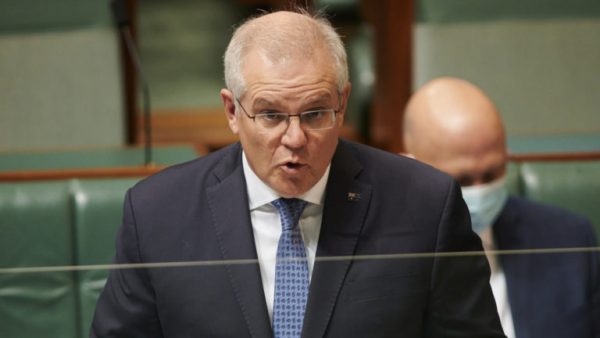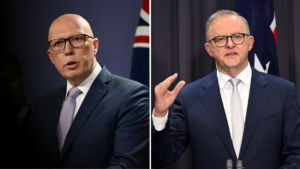
The same Prime Minister who spruiks ‘technology not taxes’ as a climate change strategy is now championing ‘pharmaceuticals not physical distancing’ in the battle against COVID-19.
As always, his slogan is more spin than science, and the phoney distinction will be dangerous to our health, our wealth and our society.
Just as virtually every economist agrees that the battle to reduce greenhouse gas emissions is best fought with technology and taxes, virtually every epidemiologist agrees that keeping Australia safe from COVID-19 needs both high vaccination rates and effective measures to keep people away from each other while potentially infectious.
In short, limitations on our ability to move, mix and mingle will be with us for quite some time and are as important as the vaccines themselves.
And no matter how many times the PM quotes the Doherty modelling, his false distinction between vaccines or lockdowns is all about messaging, not medicine.
An inconvenient truth
The inconvenient truth for Scott Morrison is that the Doherty modelling does not say it is safe to end lockdowns once the vaccination rate hits 70 or 80 per cent.
Indeed, according to the Doherty modelling we could spend up to 39 per cent of our time in lockdown if we begin to open up when vaccination hits 70 per cent.
Regardless of what the PM says, temporary city-wide lockdowns will be a near certainty for Australians over the next 12 months, regardless of when we open up.
But while lockdowns are inevitable, regardless of when we open up, huge case numbers and high mortality rates are not.
If we wait until vaccination rates are high and if we wait until uncontrolled outbreaks in states like NSW are controlled, the number of deaths will be much lower than if we let the virus rip after we have given it a running start.
The importance of testing, tracing, isolation, quarantine
A key assumption in the Doherty modelling is the effectiveness of our testing, tracing, isolation and quarantine (TTIQ) regime.
Australians have heard a lot about the importance of the hard work of our contract tracers, but few probably realise that – according to the Doherty modelling – the ability of our TTIQ workforce to suppress the virus is equivalent to vaccinating more than half of the population.
Put simply, without our highly effective TTIQ regime Australia would have looked more like the UK last year than New Zealand.
But a key limitation of the Doherty modelling, and in turn, a key problem with Scott Morrison’s belief it will be safe to start opening our state borders even if the virus is raging, is the assumptions it makes about the effectiveness of TTIQ once there are thousands of cases in the community.
To be clear, the fact that the Doherty model makes assumptions about things like the effectiveness of our contract tracing and the effectiveness of vaccines is not a fundamental problem.
Models are, by definition, a simplification of reality.
But what is a problem is when a model designed for one situation is used to predict the outcome of quite a different situation. Which brings me back to Mr Morrison’s excessive confidence.
The Doherty model gives two estimates of the effectiveness of our TTIQ system: An ‘optimal setting’ based on NSW performance last year and a ‘partial setting’ based on the experience at the peak of Victoria’s second COVID19 wave.
To quote the Doherty report: “… reduced effectiveness of the public health ‘test, trace, isolate, quarantine’ (TTIQ) response is anticipated due to high caseloads”.
So far, so good.
But while the Doherty model has two scenarios for TTIQ, what it doesn’t have is a direct link in their model between the number of daily cases, the number of mystery cases, and the likely effectiveness of TTIQ.
What this means is that – even though NSW cases will possibly rise into the thousands per day by November, and even though the combined number of ‘mystery cases’ in NSW could number in the tens of thousands by then – the Doherty modelling still assumes that the effectiveness of TTIQ will be as high as it was in Victoria when there were about 700 cases per day.
Key questions the PM must answer
Given that the number of mystery cases is already rising rapidly in NSW, it’s likely that the effectiveness of TTIQ is already in rapid decline.
If that is indeed the case, then the Doherty modelling needs to be redone to consider a wider range of plausible scenarios.
With that in mind, the key questions that the Prime Minister should answer are:
- Does he agree that the effectiveness of TTIQ is likely to decline with rising case numbers?
- Does he agree that the effectiveness of TTIQ is also likely to decline with the number of unlinked cases in the community?
- Given the NSW outbreak is already larger than the Melbourne second wave outbreak, and given that the outbreak in NSW may be significantly larger by the time that 70 or 80 per cent vaccination is reached, would it be prudent to commission additional modelling that considers the possibility that contract tracers just can’t keep up with very large outbreaks?
Morrison is desperate to shift the debate
Although it is not clear what the next 12 months will look like, what is clear is that Mr Morrison is desperate to move the debate away from the fact that he was slow to start the vaccine race and toward the fact he is now in a hurry to deliver ‘freedom’.
The only fight the Prime Minister thinks he has a chance of winning against the premiers is that their people are tired of lockdowns (of course they are) and that we shouldn’t stay in lockdown forever (has anyone ever suggested we should?)
The key question is not whether Australians want more freedom, but whether they are willing to let COVID-19 rip through the more than eight million people – most of whom are children – who will still be unvaccinated when we hit the 80 per cent vaccination threshold that Scott Morrison is so focused on.
Between the Lines Newsletter
The biggest stories and the best analysis from the team at the Australia Institute, delivered to your inbox every fortnight.
You might also like
Eight things you need to know about the Government’s plan to change Australian elections
And eight ideas to improve it
There is no such thing as a safe seat | Fact sheet
A notable trend in Australian politics has been the decline of the share of the vote won by both major parties at federal elections. One effect of this is that there are no longer any safe seats in Australian politics: minor parties and independents win more “safe” seats than they do “marginal” ones. The declining
The election exposed weaknesses in Australian democracy – but the next parliament can fix them
Australia has some very strong democratic institutions – like an independent electoral commission, Saturday voting, full preferential voting and compulsory voting. These ensure that elections are free from corruption; that electorate boundaries are not based on partisan bias; and that most Australians turn out to vote. They are evidence of Australia’s proud history as an


